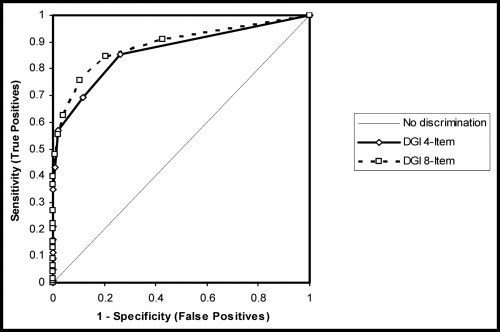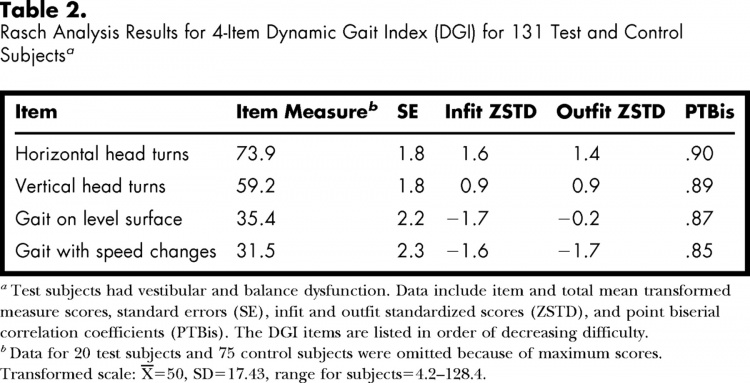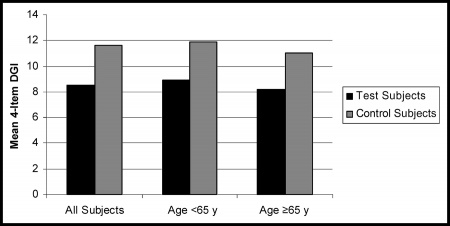4-item Dynamic Gait Index: Difference between revisions
Jeremy Bryan (talk | contribs) No edit summary |
Jeremy Bryan (talk | contribs) No edit summary |
||
| Line 6: | Line 6: | ||
</div> | </div> | ||
== | == Introduction == | ||
[[Image:Blender3D NormalWalkCycle.gif|right]] | [[Image:Blender3D NormalWalkCycle.gif|right]] | ||
The | The 4-Item Dynamic Gait Index is a shortened version of the [[Dynamic Gait Index]] (DGI) utilizing only the first four items. It is used for the clinical measurement of walking function and has been examined in patients with balance deficits, vestibular disorders, and those post stroke.<ref name=":0" /><ref name="Marchetti" /> | ||
== | == Administering Test == | ||
The first four items utilized from the DGI include: | |||
#Horizontal head turns<ref name="Marchetti" /> | |||
#Vertical head turns<ref name="Marchetti" /> | |||
#Gait on level surfaces<ref name="Marchetti" /> | |||
#Changes in gait speed<ref name="Marchetti" /> | |||
Each of the four items are scored on an ordinal scale from 0-3 with higher numbers indicating better performance of the specified task. Additionally, each item has specific criteria that must be met to be granted a specific score number.<ref name="Marchetti" /> | |||
Unlike the full DGI, the 4-Item Dynamic Gait Index does not require any equipment to administer.<ref name="Marchetti" /> | |||
== Original Reference == | == Original Reference == | ||
| Line 49: | Line 44: | ||
=== Miscellaneous === | === Miscellaneous === | ||
[[Dynamic Gait Index|Dynamic Gait Index]], the '''4-item Dynamic Gait Index''', and the [[Functional Gait Assessment|Functional Gait Assessment]] show sufficient validity, responsiveness, and reliability for assessment of walking function in patients with stroke undergoing rehabilitation, but the Functional Gait Assessment is recommended for its psychometric properties<ref>Lin JH, Hsu MJ, Hsu HW, Wu HC, Hsieh CL. [http://stroke.ahajournals.org/cgi/content/abstract/STROKEAHA.110.589739v1 Psychometric Comparisons of 3 Functional Ambulation Measures for Patients With Stroke]. Stroke. 2010 Jul 29; | [[Dynamic Gait Index|Dynamic Gait Index]], the '''4-item Dynamic Gait Index''', and the [[Functional Gait Assessment|Functional Gait Assessment]] show sufficient validity, responsiveness, and reliability for assessment of walking function in patients with stroke undergoing rehabilitation, but the Functional Gait Assessment is recommended for its psychometric properties<ref name=":0">Lin JH, Hsu MJ, Hsu HW, Wu HC, Hsieh CL. [http://stroke.ahajournals.org/cgi/content/abstract/STROKEAHA.110.589739v1 Psychometric Comparisons of 3 Functional Ambulation Measures for Patients With Stroke]. Stroke. 2010 Jul 29; 41:9.</ref>. | ||
<br> | <br> | ||
Revision as of 17:09, 6 March 2023
Original Editor - Rachael Lowe. Top Contributors - Jeremy Bryan, Rachael Lowe, Gayatri Jadav Upadhyay, Admin, Laura Ritchie, Wendy Walker, Kim Jackson, Tony Lowe, WikiSysop, Naomi O'Reilly, Karen Wilson, Lucinda hampton and Evan Thomas
Introduction[edit | edit source]
The 4-Item Dynamic Gait Index is a shortened version of the Dynamic Gait Index (DGI) utilizing only the first four items. It is used for the clinical measurement of walking function and has been examined in patients with balance deficits, vestibular disorders, and those post stroke.[1][2]
Administering Test[edit | edit source]
The first four items utilized from the DGI include:
Each of the four items are scored on an ordinal scale from 0-3 with higher numbers indicating better performance of the specified task. Additionally, each item has specific criteria that must be met to be granted a specific score number.[2]
Unlike the full DGI, the 4-Item Dynamic Gait Index does not require any equipment to administer.[2]
Original Reference[edit | edit source]
Marchetti GF, Whitney SL. Construction and validation of the 4-item dynamic gait index. Physical Therapy, 2006 Dec;86(12):1651-60.[2]
Evidence[edit | edit source]
The clinical psychometric properties of the 4-item DGI were equivalent or superior to those of the 8-item test. The 4-item DGI can be used by clinicians to measure gait in people with balance and vestibular disorders without compromising important clinical measurement characteristics[2].
Reliability[edit | edit source]
Validity[edit | edit source]
Miscellaneous[edit | edit source]
Dynamic Gait Index, the 4-item Dynamic Gait Index, and the Functional Gait Assessment show sufficient validity, responsiveness, and reliability for assessment of walking function in patients with stroke undergoing rehabilitation, but the Functional Gait Assessment is recommended for its psychometric properties[1].
References[edit | edit source]
- ↑ 1.0 1.1 Lin JH, Hsu MJ, Hsu HW, Wu HC, Hsieh CL. Psychometric Comparisons of 3 Functional Ambulation Measures for Patients With Stroke. Stroke. 2010 Jul 29; 41:9.
- ↑ 2.0 2.1 2.2 2.3 2.4 2.5 2.6 2.7 2.8 Marchetti GF, Whitney SL. Construction and validation of the 4-item dynamic gait index. Physical Therapy, 2006 Dec;86(12):1651-60.










